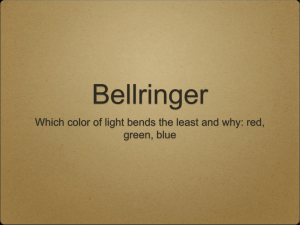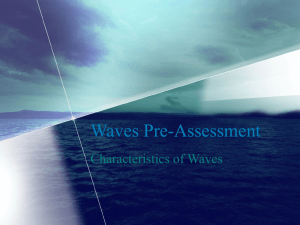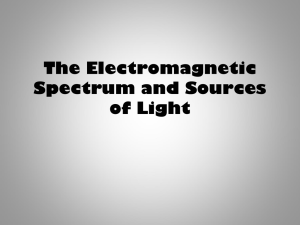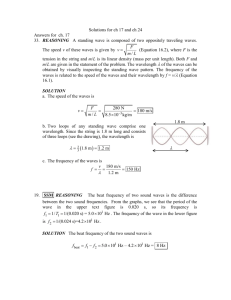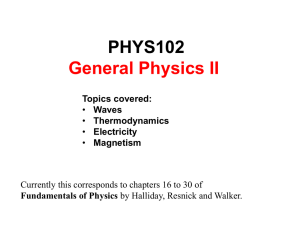Longitudinal waves
advertisement
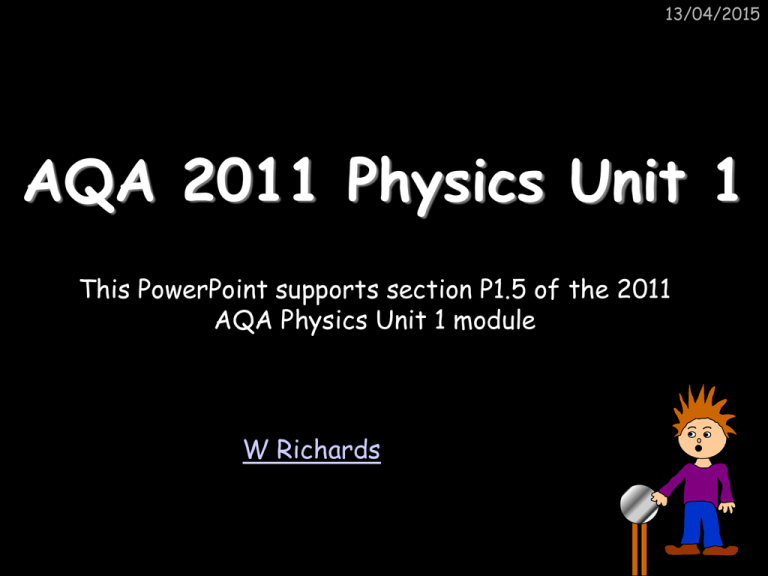
13/04/2015 AQA 2011 Physics Unit 1 This PowerPoint supports section P1.5 of the 2011 AQA Physics Unit 1 module W Richards An introduction to Waves 13/04/2015 Some definitions… 1) Amplitude – this is “how high” the wave is: 2) Wavelength () – this is the distance between two corresponding points on the wave and is measured in metres: 3) Frequency – this is how many waves pass by every second and is measured in Hertz (Hz) 13/04/2015 “Wave behaviour” Anything that travels as a wave demonstrates wave behaviour – in other words, it can be reflected, refracted and diffracted: Reflection Refraction Diffraction 13/04/2015 Transverse vs. longitudinal waves Transverse waves are when the displacement is at right angles to the direction of the wave (e.g. light and other electromagnetic waves)… Displacement 13/04/2015 Displacement Direction Direction Longitudinal waves are when the displacement is parallel to the direction of the wave (e.g. sound waves)… Where are the compressions and rarefactions? The Electromagnetic Spectrum 13/04/2015 Each type of radiation shown in the electromagnetic spectrum has a different wavelength and a different frequency: High frequency, _____ wavelength Gamma rays X-rays Low frequency, _____ (high) wavelength Ultra violet Visible light Infra red Microwaves Radio/TV γ Each of these types travels at the same speed through a _______ (300,000,000m/s), and different wavelengths are absorbed by different surfaces (e.g. infra red is absorbed very well by ___________ surfaces). This absorption may heat the material up (like infra red and _______) or cause an alternating current (like in a __ _______). Words – black, microwaves, long, short, TV aerial, vacuum The Electromagnetic Spectrum 13/04/2015 Type of radiation Uses Dangers Gamma rays Treating cancer, sterilisation Cell mutation X rays Medical Cell mutation Ultra violet Sun beds Skin cancer Visible light Seeing things None (unless you look at the sun) Infra red Remote controls, heat transfer Sunburn Microwaves Satellites, phones Very few TV/radio Communications Very few The Wave Equation 13/04/2015 All E-M waves obey the Wave Equation: Wave speed (v) = frequency (f) x wavelength () in m/s in Hz in m V f Some example wave equation questions 13/04/2015 1) A water wave has a frequency of 2Hz and a wavelength of 0.3m. How fast is it moving? 0.6ms-1 2) A water wave travels through a pond with a speed of 1ms-1 and a frequency of 5Hz. What is the wavelength of the waves? 0.2m 3) The speed of sound is 330ms-1 (in air). When Dave hears this sound his ear vibrates 660 times a second. What was the wavelength of the sound? 0.5m 4) Purple light has a wavelength of around 6x10-7m and a frequency of 5x1014Hz. What is the speed of purple light? 3x108ms-1 How sound travels… 13/04/2015 As we know, sound waves are formed when something vibrates. But how does the sound reach our ears? Air molecules 1) An object makes a sound by vibrating 2) The vibrations pass through air by making air molecules vibrate 3) These vibrations are picked up by the ear Transmitting information 13/04/2015 Although E-M radiation travels in straight lines, we can send infra-red and light signals around a curved path using an optical fibre: Optical fibres have two main advantages: they can send more information compared to electrical cables of the same diameter and with less signal weakening. Microwaves are used by satellites because they can pass through the Earth’s atmosphere: Microwaves are also used in mobile phone networks. Reflection 13/04/2015 Angle of incidence = Angle of reflection Normal Reflected ray Incident ray Angle of incidence Angle of reflection Mirror 13/04/2015 Evidence about the origins of the universe… 13/04/2015 Source of light “Spectra” 13/04/2015 If you pass the light through a gas something different is seen… helium Some wavelengths of light are absorbed by the gas – an “absorption spectrum”. If the light source is moving away the absorption spectra look a little different… 13/04/2015 Before helium helium After The absorption lines have all been “shifted” towards the longer wavelength end (red end)… This is called red shift. The faster the light source moves the further its light will be “shifted” Before After A similar effect happens with sound – this is called “The Doppler Effect” 13/04/2015 Red Shift simplified 13/04/2015 Basically, if I walk towards you I’ll look slightly more blue. Then, if I walk away from you, I’ll look slightly more red!! Let’s try it… 13/04/2015 13/04/2015 13/04/2015 Light from different stars and from the edge of the universe also shows this “red-shift”. This suggests that everything in the universe is moving away from a single point. This is the BIG BANG theory Red shift summary 13/04/2015 Light from other galaxies has a longer _________ than expected. This shows that these galaxies are moving ____ from us very quickly. This effect is seen to a greater extent in galaxies that are _______ away from us. This indicates that the further away the galaxy is, the ______ it is moving. This evidence seems to suggest that everything in the universe is moving away from a single point, and that this process started around 15 _____ years ago. This is the ____ ________ Theory. Further evidence of this theory is Cosmic Microwave Background Radiation (CMBR) – this radiation comes from the Big Bang and fills the _________. Words to use – faster, away, universe, big bang, billion, wavelength, further 13/04/2015 This slideshow has been made freely available on the TES Resources website. More Science PowerPoints like this can be found at the website www.educationusingpowerpoint.com. This site contains slideshows that cover the 2011 AQA, EdExcel, OCR Gateway and OCR 21st Century courses (with more material being added every year) and A Level Physics and KS3 material. Some slideshows are free, others require a small subscription fee to be taken out (currently only £50 for a year). Further details can be found at Education Using PowerPoint.

